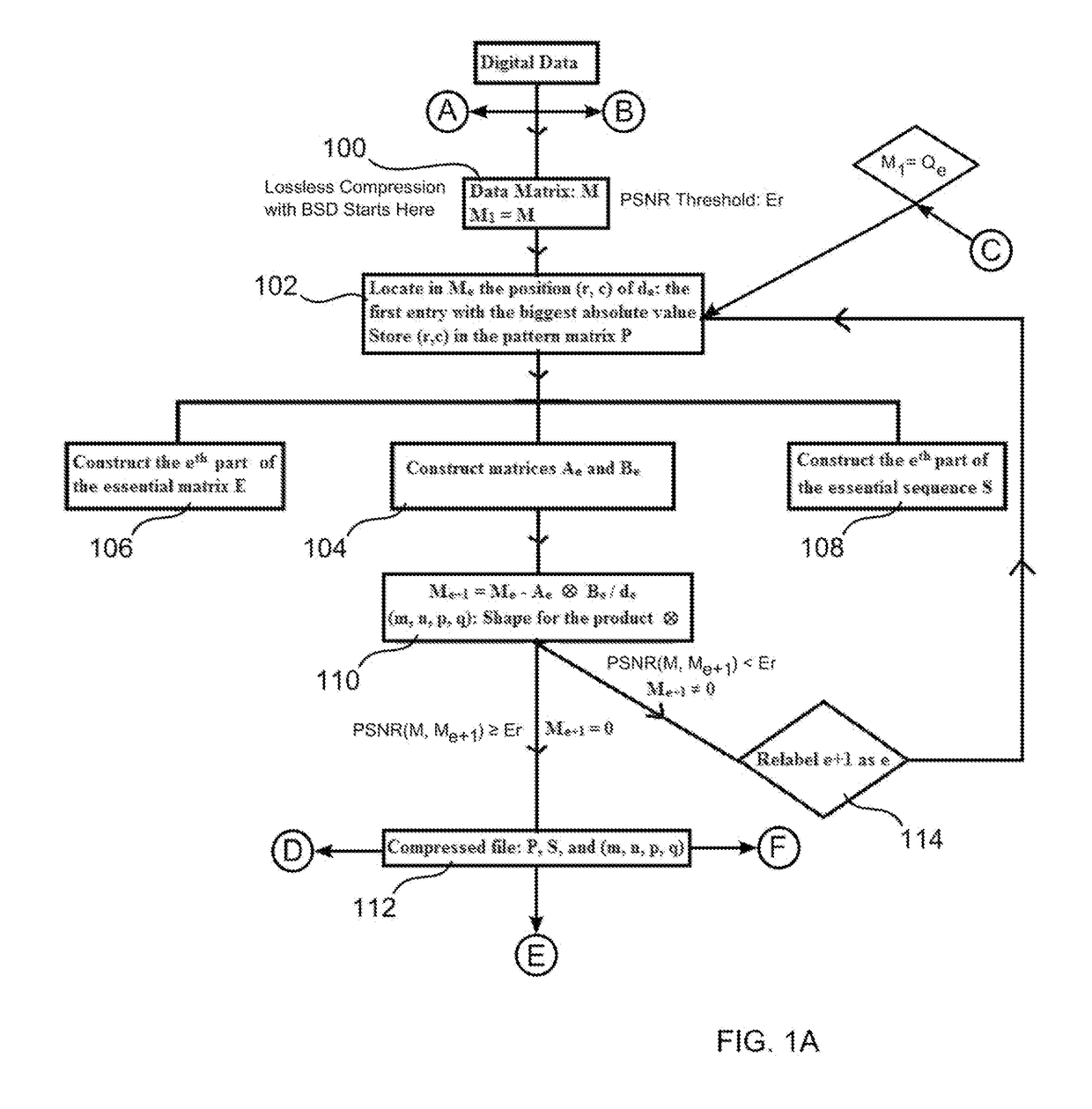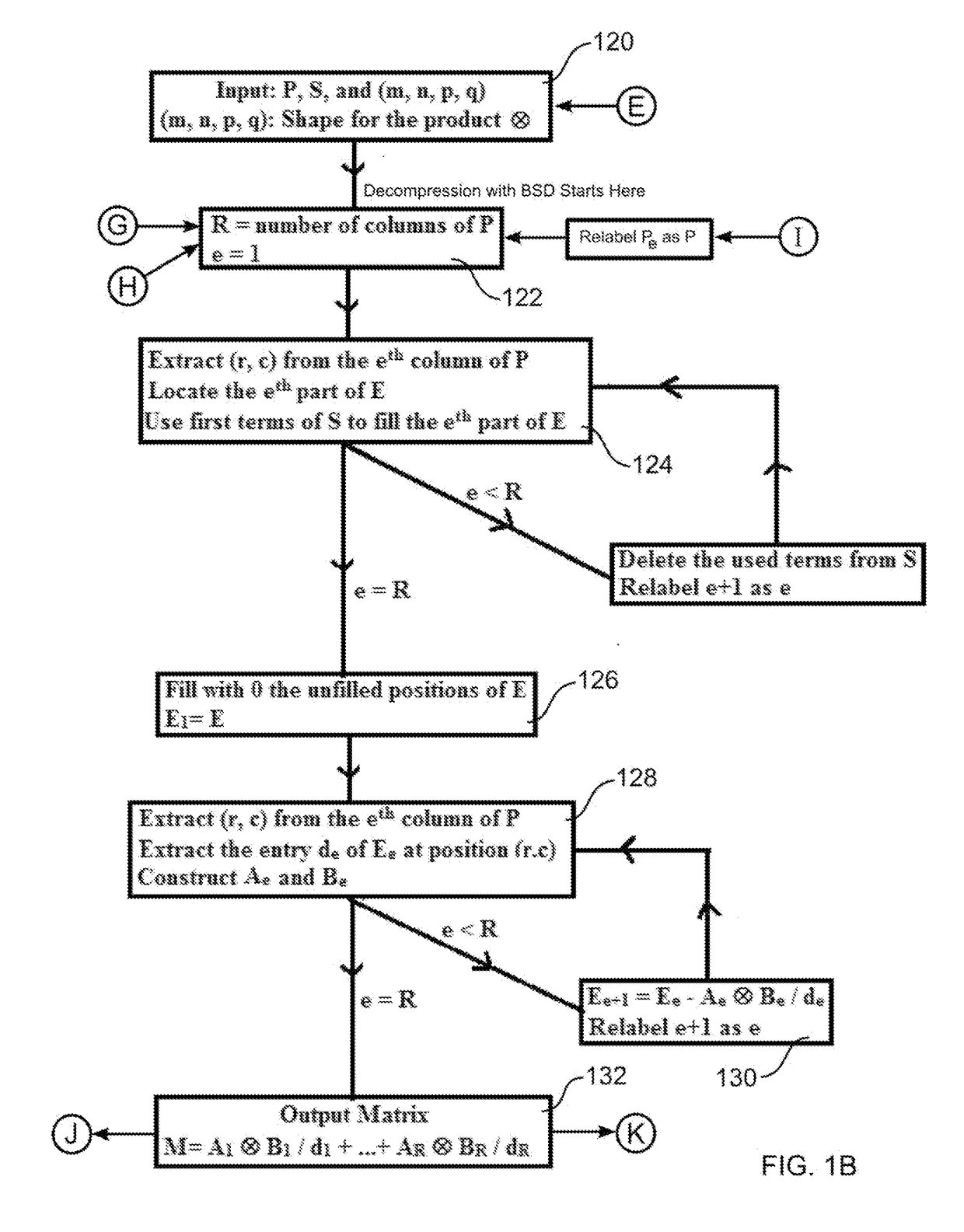Data adaptive compression and data encryption using kronecker products
a data adaptive compression and data encryption technology, applied in the field of file compression using matrices, can solve the problems of lossy compression of digital files, unsatisfactory compression ratio of svd,
- Summary
- Abstract
- Description
- Claims
- Application Information
AI Technical Summary
Benefits of technology
Problems solved by technology
Method used
Image
Examples
example 1
[0036]Consider the 6×6-matrix M whose entries are integers between 0 and 255. Thus, 36 Bytes is the memory space required to store M in a computer. In this example, BSD is used to decompose M with respect to (3, 2, 2, 3), i.e., into a sum of matrices, for which each term is the Kronecker product of a 3×2 matrix by a 2×3 matrix.
M=(1_2_3_4_567_8_9101112_13_141516_1718192021_222324_25_262728_29_30_313233_34_35_36_)M=A1⊗B1+A2⊗B2,whereA1=(91221243336)B1=(28 / 3629 / 3630 / 3634 / 3635 / 3636 / 36)(4.2)A2=(1-9(28 / 36)4-12(28 / 36)13-21(28 / 36)16-24(28 / 36)25-33(28 / 36)28-36(28 / 36))A2=(1-9(28 / 36)1-9(28 / 36)2-9(29 / 36)1-9(28 / 36)3-9(30 / 36)1-9(28 / 36)7-9(34 / 36)1-9(28 / 36)8-9(35 / 36)1-9(28 / 36)9-9(36 / 36)1-9(28 / 36))
[0037]The entries of A1, A2, B1, and B2 are computed using the essential sequence S=(9, 12, 21, 24, 33, 36, 28, 29, 30, 34, 35, 1, 4, 13, 16, 25, 2, 3, 7, 8) whose terms are called essential entries of M (these entries are bolded and underlined in M). The methodology for selecting essential entries is provi...
embodiment 1
Decompression
[0060]With reference to FIG. 1B, in the decompression process, the quadruple (m, n, p, q), the matrix P, and the sequence S constitute the input (120).
[0061]Step 1: The software computes R that is equal to the number of columns in P (122).
[0062]Step 2: Starting with e=1 and finishing with e=R, the apparatus performs the following substeps for each e (124).
[0063]Step 2.1: The apparatus extracts the ordered pair (r, c) from the eth column of P.
[0064]Step 2.2: The software performs the Euclidean division of c by q and find the reminder j. If the reminder is zero, then j is replaced with q. The software then computes i=(c−j) / q+1.
[0065]Step 2.3: The software performs the Euclidean division of r by n and find the reminder l. If the reminder is zero, then l is replaced with n. The software then computes k=(r−l) / n+1.
[0066]Step 2.4. Following the lexicographic order of the set {(a,b): 1≦a≦m and 1≦b≦p}, the apparatus stores the first terms of S that are enough to fill in E every ...
embodiment 2
Decompression
[0092]With reference to FIG. 2B, for the decompression process, the input is the compressed file that includes the quadruple (m, n, p, q), the matrix P, the sequence S, the sequence R, and the size of M (180).
[0093]Step 1. The software computes h as the number of terms of R (182).
[0094]Step 2. For each e=1, . . . , h, the apparatus performs the following steps to find the eth block of the output matrix.
[0095]Step 2.1. The software extracts from the input matrices the matrix Pe as the rows (2e−1) and 2e of the pattern matrix P and extracts from R the number Re (184).
[0096]Step 2.2. With the matrix Pe, the number Re, and the sequence S, the apparatus uses steps 2-5 of the decompression process of embodiment 1 to build a block matrix Ne that approximates the original block Me (186). The pigeonhole principle is used to replace S with a new sequence that includes all terms of S but the terms used in Step 2.2. After that the old sequence is deleted and the new sequence is cal...
PUM
 Login to View More
Login to View More Abstract
Description
Claims
Application Information
 Login to View More
Login to View More - R&D
- Intellectual Property
- Life Sciences
- Materials
- Tech Scout
- Unparalleled Data Quality
- Higher Quality Content
- 60% Fewer Hallucinations
Browse by: Latest US Patents, China's latest patents, Technical Efficacy Thesaurus, Application Domain, Technology Topic, Popular Technical Reports.
© 2025 PatSnap. All rights reserved.Legal|Privacy policy|Modern Slavery Act Transparency Statement|Sitemap|About US| Contact US: help@patsnap.com



